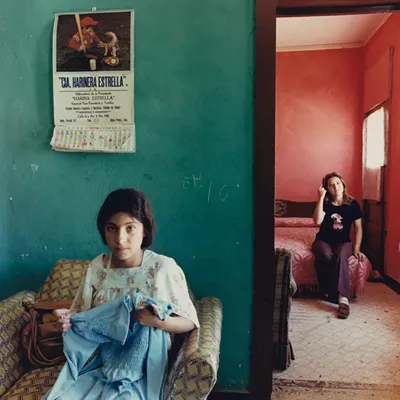Forget, for a moment, the torments of hell depicted on the far side of Hieronymus Bosch's glorious painting "The Garden of Earthly Delights." Close your eyes to the sinners being gobbled up by giant birds or manhandled by crusty black bugs. And put aside, for now, the fleshy orgy unfolding ecstatically in the center panel.
Concentrate instead on the stately panel at left, where Adam and Eve are about to receive a bountiful earthly paradise from God the Father. Their fertile new landscape is filled with animals and apple trees—that fruit will play a big part later—and strangely shaped prickly plants.
It's that Garden of Eden in Bosch's 15th-century painting that inspired New Earthly Delights, a show at Etherton Gallery that luxuriates in the natural world.
Flo Perkins' garden of brilliantly colored glass cacti thrives beneath crayon-bright flower paintings by Gail Marcus-Orlen. Mayme Kratz traps bits of leaves and twigs in resin and poses them against shadowy landscapes photographed by Tim Lanterman.
The Kratz-Lanterman works edge toward Bosch's darker vision, while Perkins and Marcus-Orlen mostly celebrate the bright pleasures of Earth's beauty.
Bosch might not have understood just how Perkins makes her glass garden grow, but he would have applauded its fantastical shapes and colors. Trained at the Philadelphia College of Art and UCLA, Perkins has lived for years in New Mexico. During those years, she has made a specialty of translating the Southwest's surreal plant life into shimmering glass. (Her exhibition opened as part of ¡Viva el Vidrio!, the Tucson Glass Festival.)
Perkins works in hot blown glass, a medium that's difficult and slow. To make a glass cactus, she notes in an artist's "recipe," you need "two, three or four assistants, a teaspoon of ability, a cup of patience (and) a month of time."
She has 14 individual pedestal pieces in this show, all of them spectacularly crafted. "Melocactus," 2008, is a squat barrel cactus intricately patterned in greens and topped by, oh, maybe a thousand red glass prickers. Wavy white glass flowers sprout deliriously from "87 Year Old Cactus."
But Perkins' most spectacular creation is "Arid Dream," a sculptural installation with no fewer than 52 glass cacti planted in gravel. Nearly 15 feet long, the garden sits on a 3-foot-high box that stretches along nearly the whole of one gallery wall.
At the center of this rocky bed is a troop of glittering prickly pears, colored lime green and sprouting orange flowers. Some barrel cacti sport lime-green fuzz on top, along with purple posies. Some of the wild succulents thriving here, though, look only a little like real-life cacti. Perkins improvises, turning out a quartet of shiny round specimens in royal blue. Bright-green columns burst out into a crown of canary-yellow flowers. And tall turquoise stalks shoot up into the air, with fuzzy lime prickers exploding out of their tips.
In fact, these suggestive forms veer away from the sedate Garden of Eden. You could even say that they're straying into the precincts of Bosch's painted orgy, where the artist celebrated the sexual energy of both plants and humans, painting exploding stalks and lovers cavorting in a dreamlike landscape. Perkins herself says that she looks to cacti to learn how to live in harsh desert and "how to adapt to survive." Her exuberant glass examples, vigorous and fertile, are not only surviving, but thriving in their dry rock.
Appropriately enough, Marcus-Orlen's extravagant flowers bloom on the wall right above Perkins' fecund garden. The longtime Tucson artist paints in oil on canvas, using a distinctive palette that makes the paintings immediately recognizable as hers. She favors lavender, amber, cherry and pink, blues and bright green, painted in strokes that are tidy and brushy at the same time.
"Blue Life," one of 19 paintings here, is a sumptuous example. An array of flowers and fruits are strewn across a flat background, where a gorgeous pale purple segues into turquoise. It's a modernist space that suggests—but doesn't depict—a flat surface, a tabletop, perhaps.
Nothing overlaps; instead, each purple iris, every yellow rose, lies alone among its curling leaves. Cherries, pears, oranges and those fateful apples are in between. All these fruits of the earth are brightly lit and glisten as easily and as readily as Perkins' glass. The flowers and fruit could almost be sitting on top of the canvas, ready to pick or eat.
Marcus-Orlen specializes in this kind of optical illusion. Sometimes, like an Old Master of Bosch's era, she'll paint a shelf at the bottom of her canvas, making the wooden board so realistic that a viewer can be forgiven for believing that it's really jutting out into the air.
"Enchanted 3," a luscious green painting adorned with painted orange tiger lilies and a purple iris, has a shelf at the bottom. A tiny painted turtle crawls along it, along with a trio of ladybugs; a peach is at one end, a pear at the other. A hummingbird and butterflies flitter above the flowers. The painting is so three-dimensional, it pushes toward the sculptural.
Other paintings are filled with long-time Marcus-Orlen motifs: arches; checkerboards that are sometimes game boards, sometimes tiled floors; windows with sky views; and cats. Humans make a few appearances in these dream spaces, as mimes, as sculptural heads. A few paintings portray a young woman in profile. But even in these works, the main thing is the benevolence of the natural world.
Kratz and Lanterman's 29 mixed-media works, from their Dark Matter series, take a grimmer view. Phoenix artist Kratz's last Etherton show featured resin solo works in luminous, lovely blues. Here, teaming up with photographer Lanterman, she mostly stays in monochromatic browns and beiges.
She's kept to her old technique, capturing real bits of nature and preserving them in thick resin, but Lanterman's sepia photos add a moody background. Like Marcus-Orlen, Kratz plays with optical illusion. Her leaves and stems and animal bones appear to be floating above the surface of the works, but like Marcus-Orlen's flowers, they're not. Kratz's found objects are embedded within the smooth resin.
These painterly pieces are delicate and evocative and, occasionally, even playful. "Dark Matter—001" has grasshopper wings making their way across a gray sky, like a bird in flight. "022" positions a leaf at the edge of a sea, looking like an old-time sailing ship about to embark.
But some suggest storms and lurking disaster. "032" is a murky landscape, relieved only by a few curls of agave. "031" has pale palo verde branches uneasily posed against a dark amber sky.
A necklace of white animal bone circles close to the surface of the ominous "Dark Matter—005." Below this top layer is a dark image of a forest; beyond that, barely glimpsed between the trees, is a blazing orange sky. In its intimation of Armageddon—with its bone noose and forest ablaze—this one comes closest to Bosch's fearsome hell fires.












